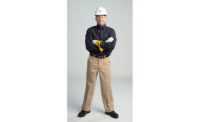According to OSHA, arc flash burns are one of the top three most common hazards when working with energized electrical equipment.
Every day in the U.S. there are up to 10 arc flash incidents, totaling more than 3,600 disabling electrical contact injuries each year. The violent nature of arc flash exposure, which can result in a fatality, even if a worker is 10 feet from the blast site.
Determine hazard potential
Unsafe work environments, including dust, dropping tools, accidental touching, condensation, material failure, corrosion and faulty installation, can cause arc flash hazards. Conduct an arc flash hazards audit, looking for situations in which workers can be on or near exposed and energized equipment, or in a hazardous environment. Collect detailed data and information, such as transformer nameplates, conductor sizes and circuit breaker settings, and then create a current one-line electrical drawing. When determining which data to collect, refer to National Fire Protection Agency (NFPA) 70E requirements for safe workplace practices.
Reduce exposure
Ask a licensed professional engineer with a thorough working knowledge of NFPA 70E requirements to identify ways to reduce or eliminate potential arc flash hazards, such as de-energizing equipment; preventing or limiting worker access with insulating, guarding or barricades; and tagging equipment with NFPA-compliant arc flash hazard and electrical shock warning labels.
Calculate arc flash boundary
Work with the licensed professional engineer to determine the minimum required, safe working distance from each piece of equipment for which an arc flash hazard exists. Use a reliable source or methodology, such as NFPA 70E tables or formulas, IEEE Standard 1584 formulas or spreadsheet calculator, or boundary calculations software.
Protect employees
To assist employers in ensuing that workers exposed to electric arc hazards do not wear clothing that can melt onto skin or ignite and burn when exposed to arc flash, as well as to mitigate the physical impact of arc flash, use AF (arc flash)-rated PPE, which meets OSHA 1910.269(L)(8) as well as ASTM F887 arc flash requirements.
Head, face & eye protection
AF-rated eye/face protection products, including face shields, safety spectacles and goggles, must be worn by at-risk workers. Such PPE must resist high heat and maintain necessary structural integrity in the face of arc flash hazards. Look for the arc flash system to ensure your selection of AF-rated protection.
Personal fall protection
AF-rated, full-body harnesses are built to withstand an arc flash impact and perform as required in the event of a fall.
3 causes of arc flash
- Human error: unsafe work procedures, maintenance mistakes, and mishandling tools, wires, and metal covers;
- Negligent preventive maintenance: not checking for loose termination, allowing dust and debris build-up (critical in medium voltages and higher), and not testing stored energy (e.g., spring-operated bolted pressure switches); and
- Improper electrical equipment/system design - incorrect modifications or using legacy equipment that doesn’t meet current arc flash standards.
Common fallacies
The causes listed above create numerous opportunities to cause a flash and just as many opportunities to misunderstand how to prevent it. Here is a list of fallacies that persist:
- Arc flash explosions do not happen because I’ve never seen one.
- NFPA-70E is the standard governing arc flash – It’s really about reducing live work by de-energizing a circuit first and putting it in an electrically safe condition before starting to work.
- AFH labeling equals compliance with NFPA-70E - To work on any energized equipment above 50 volts, an energized work permit is required. 70E warns qualified workers of potential danger — it doesn’t give anyone authority or consent to work on energized equipment simply because he or she has complied with the PPE requirements label.
- Arc flash analysis is simply panel labeling - Arc flash analysis is about hazard reduction. It is not merely PPE or wardrobe selection.
- Assessing equipment under 240 volts from a transformer rated below 125 kVA isn’t necessary - OSHA regulations and NFPA-70E standards mandate all equipment operating at 50 volts and higher must be tested for electrical shock and potential AFH.
- Regular infrared scans of equipment rule out doing an arc flash analysis - Arc flash can be caused by equipment failure or loose connections, but most injuries are caused by human error and will only be avoided through regular analysis of equipment, work practices, and safety training programs.
- Beyond the Motor Control Center (MCC), it isn’t necessary to check equipment for AFH - Just because the MCC is the final access point of power for motor loads, doesn’t mean there isn’t a need to assess other loads, which are fed from it.
- Current-limiting fuses reduce most AFH – These don’t thoroughly address the duration component of arc flash. A current-limiting fuse will mitigate AFH only if the fault current is high enough.
- There’s no AFH if there’s no exposed, energized conductors or circuit parts – For most equipment, the probability of an arc flash may be very low, but it’s certainly not impossible. Inserting or removing draw-out circuit breakers, bus plugs and MCC buckets can cause an arc flash where, normally, is no perceived hazard — “normally” operating electrical equipment has been known to fail.
- Downstream arc flash hazards are always less violent than upstream arc flash hazards – run a full assessment, up and downstream.
Sources
- www.datacenterknowledge.com
- https://www.utilityproducts.com/home/article/16025734/what-you-need-to-know-to-protect-workers-from-an-arc-flash-hazard




